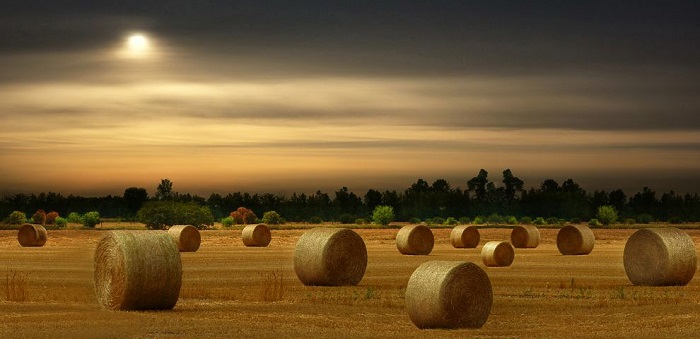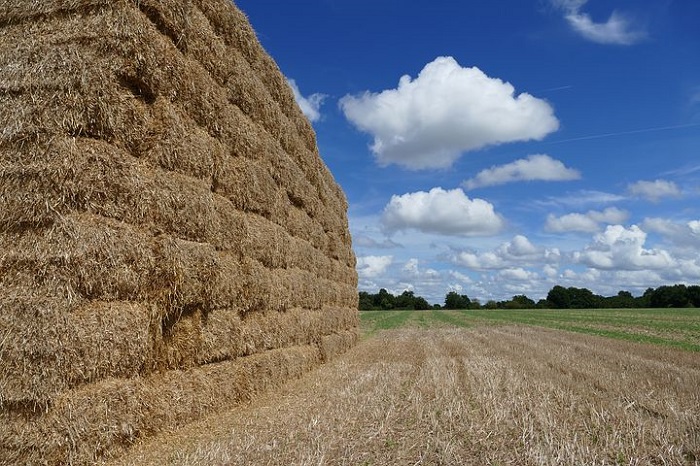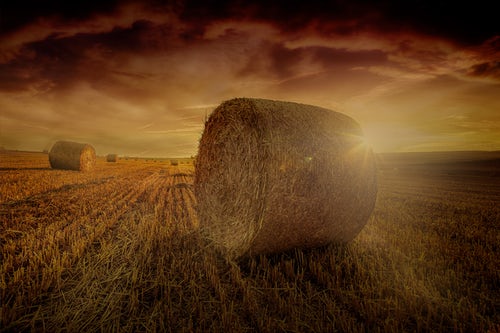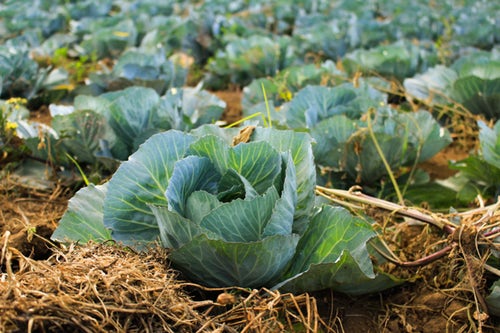
Hay mulch vs. Straw mulch: In the battle to control weeds, add fertility, and improve the water retention of your soil, is one really better than the other? Well, in a word . . . YES!
The Difference Between Straw and Hay
Let’s start at the beginning. What is the difference between straw and hay? Or are they essentially the same thing?
Many people think they’re identical because they’re both often tied into square or rectangular bales, but a closer look reveals that they’re actually quite different. Understanding these differences may help in your decision about which material better suits your gardening needs.
Characteristics of Straw
Straw is the stalk of a cereal crop such as oats, barley, wheat, or rye after harvesting has removed the seed heads. Usually a big machine called a combine harvester will come along into the field. In one smooth operation, it chops off the top portion containing the grain and sends the grain in one direction for processing, and then cuts the straw and collects it until a bale-sized block is formed. The straw bale is automatically tied and is then dropped out of the machine, back onto the field for later collection.
In many parts of the world, straw is seen as a waste product, a secondary by-product of the cereal crop, and is sold for practically nothing. But where I live in Nova Scotia, Canada, it is actually more expensive to buy straw than it is to buy hay, because not much straw is produced locally. What straw we have is quickly purchased for animal bedding. We just don’t have the climate for mass cereal crop production.
Characteristics of Hay
Hay refers to grass that has been cut while green, dried, and then made into square or round bales. Hay is used mainly for feeding animals when no fresh grass is available. It provides bulk, fiber, sugar, and nutrients to animal diets.
The best hay smells sweet, and if you take a handful and get it wet, it still looks like grass. (Straw has an almost exclusively yellow color when it is baled, and just a hint of a smell.) Hay bales can look like a greenish coarse grass, fine grass, or even flowery and weedy grass; it entirely depends on what plants were cut and dried to make the bales. The quality can vary hugely depending on the skill of the farmer making the bales and the quality of his hay fields.
It is very important to get hay that has been dried to the optimum level, so that it’s not crumbly but is dry enough to discourage mold growth. Overly dried hay starts to compost quickly when it is damp, and composting hay bales have been known to heat up and start barn fires.

Straw Mulch vs. Hay Mulch
So now that you know the difference between straw and hay . . . why would you choose one over the other for mulching your garden? I mean, it’s just mulch, right?
The benefits of mulch in a garden cannot be overstated and, if you’re reading this article, I assume you already know how terrific it is for controlling weeds and providing walkways.
A good mulch also helps the soil to remain cool and moist longer in summer and can insulate the soil in colder weather. Mulch creates a microclimate over your soil by essentially acting as a blanket to protect it from the harsh drying effects of the sun and wind.
All mulches perform this action, including our straw and hay—but did you know that other mulches used around the world have included wood chips, bark, shredded leaves, and even rocks?
Yes, rocks.
The inhabitants of Easter Island recognized that mulching prevented the wind and rain from eroding the valuable topsoil, so they used volcanic rocks spaced out on their fields as a lithic mulch to slow runoff and wind erosion. (But I can’t imagine most of us deliberately placing rocks in the garden, can you? I know that in my own garden, I’m constantly doing the opposite, because every year my garden seems to grow a new supply of rocks.)
Surely some of these mulching methods work better than others, wouldn’t you think? Do some work better in areas of wind or rain? Are some better suited for slopes? What about availability? These are all questions you need to answer for yourself. Then, experiment to see what actually works for you.
Planning is a huge part of having a successful and productive garden over the long term. You should choose the location wisely, taking into account the sunlight, type of soil, and climate.
But, in reality, most of us just have to use whatever we’ve got. Not everyone has 20 acres and can pick the perfect spot. So, let’s just say that you are growing in a typical home garden and the mulches you can most easily and economically get are hay and straw.
Straw Mulch
The Pros of Using Straw Mulch
Straw is a terrific insulator. The hollow stems retain air and their chopped, light, fluffy texture allows for easy spreading. In fact, the principal uses for straw in the U.S. over the past 200 years have been as animal bedding, for insulating walls in homes (or building straw bale houses), and for covering the ice in ice houses to act as insulation so that the ice is available for use during the summer.
When used in a garden, it also tends to remain lighter and fluffier than hay, and it keeps a beautiful golden appearance for quite a long time.
The surface remains dry even as the lowest layers touching the soil begin to decompose. Have you ever picked strawberries in a field? Almost certainly there was straw around the bushes and it gave you a good clean place to sit or kneel that felt soft and cushioned.
The Cons of Using Straw Mulch
Straw can be expensive depending on where you live, and you might not be able to grow it yourself. Straw can also act as a home to rodents because of its fluffy texture. It has a higher tendency to blow away in strong winds when it is first laid, unless you try very hard to pack it down.
Straw does add some bulk to your soil, but it is mostly composed of cellulose and fiber that are left over after the plant puts all its nutrients into the seed heads that were harvested for grain. Consequently, straw adds fewer nutrients back into the soil when it decomposes, and soilborne bacteria tie up the available nitrogen for a longer time to break down the tougher stalks.
Because straw is fluffier and makes less direct contact with the soil, it takes longer to decompose . . . which is both a plus and a minus. If you want to add nutrients, this is a minus, but if maintaining a cover or walkway is important, then it’s a plus.
Blown-in weeds won’t land in a moist environment and sprout but, on the other hand, in-ground weeds are more easily able to push through a straw mulch from the bottom due to its fluffy nature. You can counteract this effect by weeding, putting down some newspaper before laying the straw mulch, and using a thicker layer—perhaps 8 inches thick or more—to provide a darker environment that most weeds simply don’t have the energy to get through.
 Hay Mulch
Hay Mulch
The Pros of Using Hay Mulch
Hay is readily available and it’s possible to get a scythe and cut your own if you have a grassy area on your property. You don’t need to bale it—just cut it, let it dry, and then fork it into your wheelbarrow and wheel it over to where it’s needed. Even long grass clippings can function the same way as hay, because they’re essentially the same thing.
Hay left over from a previous year is often considered garbage by farmers who want to feed their animals the most recent and more nutritious hay. Consequently, hay is sometimes available for free during hay season in the summer. You can find it by looking at your local online advertisement site, such as kijiji or craigslist, or by asking your farming friends.
Hay contains a variety of grasses and legumes, plus often clover and other flowers (including both the leaf and stalk), so the plant nutrients are all there.
When hay decomposes, it adds significant nutrients to the soil to increase its fertility. It adds a balanced ratio of NPK, as well as all the trace minerals that were contained in the plant.
Hay tends to lay flat and pack down, so it decomposes fairly quickly.
It also has more of a sponge effect than straw does, which means that in heavy rainfalls, it buffers or slows down the amount of rain that soaks into the soil to help prevent erosion and leeching of nutrients.
Because hay packs down densely, the weeds from underneath get smothered and die very quickly. But weed seeds that blow in can sometimes sprout, especially in an older hay mulch that is very damp.
The Cons of Using Hay Mulch
In moist parts of the world, hay mulch has more of a tendency to harbor slugs and snails, so you need to keep a good eye out for them and have a method of removal ready. Hay generally doesn’t harbor mice, because it’s too dense. Hay takes on a packed and spongy texture that holds water, so sitting after wet weather is likely to leave you with a wet bum.
Hay holds moisture, allowing seeds on top to sprout, which is why some consider hay bale gardening to be such a great thing. But if you’re trying to suppress weeds, do you really want this? And often the hay itself contains seeds that will sprout once they get wet, so you could end up with a living pathway until the dry weather dries out the topmost layers of your mulch again.
Read More: “Straw Bale Gardening: How to Succeed”
Read More: “The Hidden Dangers of Straw Bale Gardening”
As hay decomposes, it is broken down by various bacteria and other organisms that all use nitrogen, just as we discussed for the decomposition of straw. So what happens is that these organisms get a new food source (your hay compost) and they multiply rapidly, which depletes the soil of nitrogen. As they run out of food, the organisms die and the nitrogen is once again available for the plants to use.
So planting directly into a hay mulch without any supplemental nitrogen source available probably isn’t the best idea.

Which Should You Choose?
Now that you know more about hay and straw as mulches, which one are you going to choose?
In a perfect world, the solution is to use both—a thick layer of hay mulch on the bottom, where it will decompose and act as a spongy reservoir for moisture, topped off with a few inches of straw that will be a dry layer, preventing blown-in weeds from sprouting and giving you a lovely, dry, golden walkway.
But we don’t all live in a perfect world, do we? We’re just trying to make the best of what we’ve got, and that’s what makes a great gardener or homesteader—the ability to problem-solve. So, I’d suggest that if you have a choice of only one type of mulch, you use hay simply for the fertility it will add to your soil.
As all practical gardeners know, you use what you have or can easily get. Why pay money for straw if a local farmer will give you hay in July for nothing? If you can get it free, but you don’t need it all at once, then simply put the extra bales out by your garden, throw a tarp over them, and save them for next year. If the hay gets wet and starts to compost itself, it really doesn’t matter. It’s all going in the soil in the end anyway, and the pile of bales can act as a windbreak while it waits to be used.
A garden is a living, breathing thing. It evolves from year to year and, as gardeners, we are the stewards of the fertility that is in our soil. It depends on us to pay attention and make sure that we don’t take out more than we put back in. After all, we want our gardens to feed us for many years to come and to be places where we can teach our children and grandchildren the mysteries of growing their own food, too.
Gardens are places where families and communities come together to work, talk, and visit, so we should try to make sure that, in addition to teaching the value of work, we also find pleasure in being outdoors. Planning the best method of mulching your garden is important for fertility and moisture retention, and it will also significantly reduce the amount of time you spend watering and weeding, which will in turn increase your enjoyment of your garden.
A well-mulched garden also makes better use of the precious water resources that are becoming scarce in so many places. As a fellow gardener, I encourage you to try new things and experiment with mulches to see what works for you. But most of all, have fun in the garden!